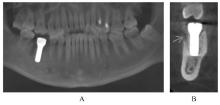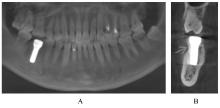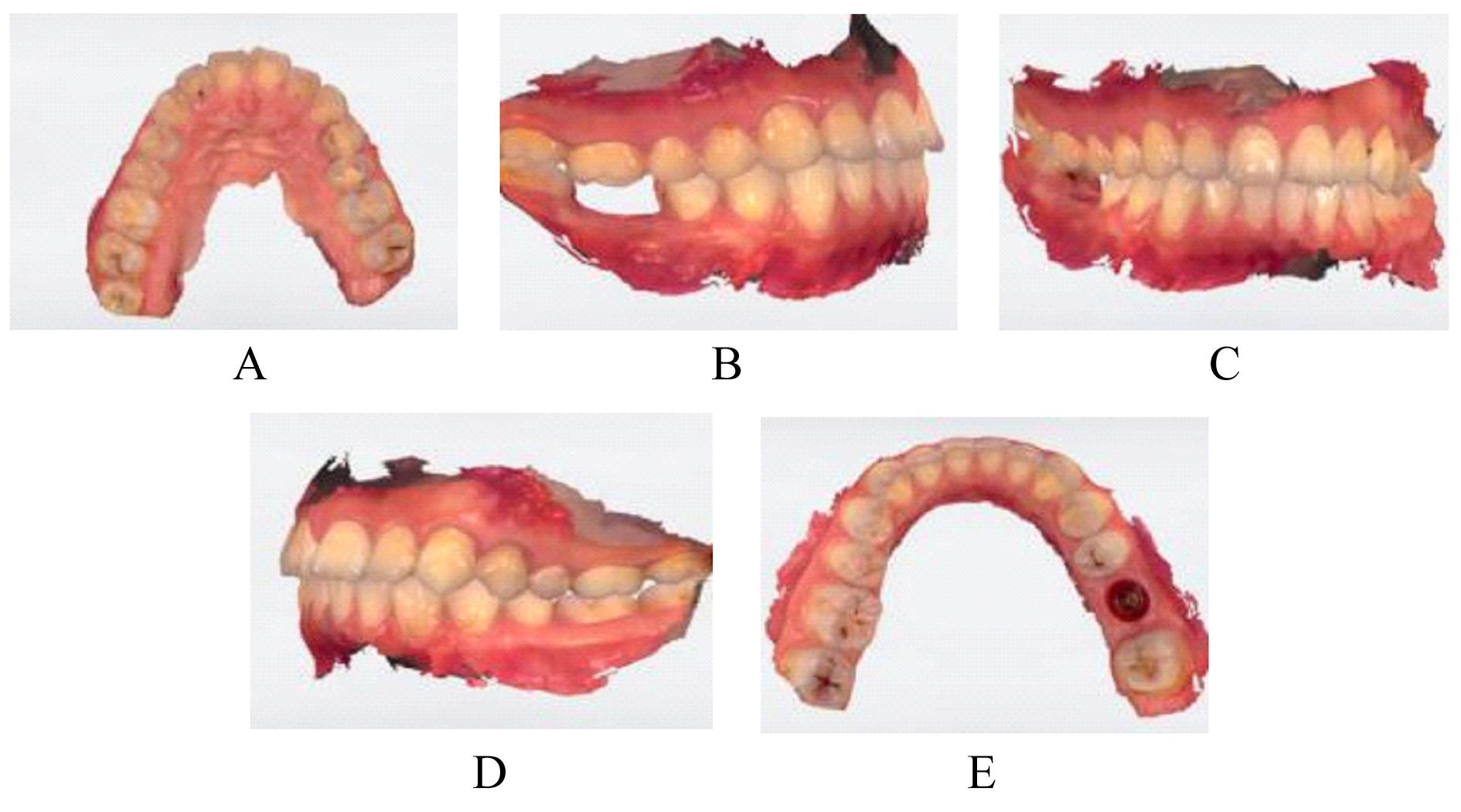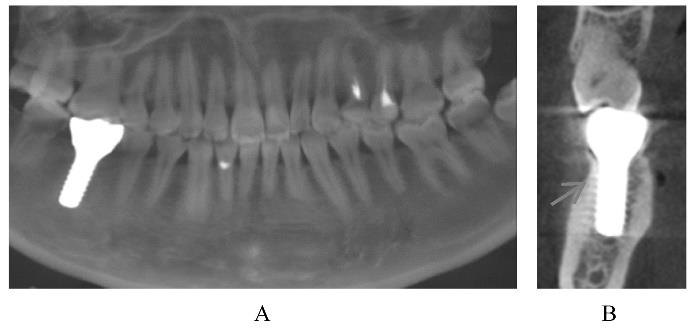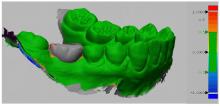Journal of Jilin University(Medicine Edition) ›› 2024, Vol. 50 ›› Issue (2): 536-544.doi: 10.13481/j.1671-587X.20240229
• Clinical medicine • Previous Articles
Application of autologous platelet-rich fibrin in immediate implant placement of molar with periapical periodontitis: A case report and literature review
Kewen JIA,Yuemeng ZHU,Siyu CHEN,Minghui LI,Jiaqian YOU,Sheng CHEN,Yanmin ZHOU( )
)
- Center of Oral Implantology,Stomatology Hospital,Jilin University,Changchun 130021,China
-
Received:2023-04-26Online:2024-03-28Published:2024-04-28 -
Contact:Yanmin ZHOU E-mail:zhouym@jlu.edu.cn
CLC Number:
- R781.341
Cite this article
Kewen JIA,Yuemeng ZHU,Siyu CHEN,Minghui LI,Jiaqian YOU,Sheng CHEN,Yanmin ZHOU. Application of autologous platelet-rich fibrin in immediate implant placement of molar with periapical periodontitis: A case report and literature review[J].Journal of Jilin University(Medicine Edition), 2024, 50(2): 536-544.
share this article
| 1 | SLAGTER K W, RAGHOEBAR G M, HENTENAAR D F M, et al. Immediate placement of single implants with or without immediate provisionalization in the maxillary aesthetic region: a 5-year comparative study[J]. J Clin Periodontol, 2021, 48(2): 272-283. |
| 2 | DE OLIVEIRA-NETO O B, LEMOS C A, BARBOSA F T,et al. Immediate dental implants placed into infected sites present a higher risk of failure than immediate dental implants placed into non-infected sites: systematic review and meta-analysis[J]. Med Oral Patol Oral Cir Bucal, 2019, 24(4): e518-e528. |
| 3 | QUIRYNEN M, VAN ASSCHE N, BOTTICELLI D. How does the timing of implant placement to extraction affect outcome?[J]. Int J Oral Maxillofac Implants, 2007, 22(): 203-223. |
| 4 | VON ARX T, HÄNNI S, JENSEN S S. Correlation of bone defect dimensions with healing outcome one year after apical surgery[J]. J Endod, 2007, 33(9): 1044-1048. |
| 5 | ZUFFETTI F, CAPELLI M, GALLI F, et al. Post-extraction implant placement into infected versus non-infected sites: a multicenter retrospective clinical study[J]. Clin Implant Dent Relat Res, 2017,19(5): 833-840. |
| 6 | KAKAR A, KAKAR K, LEVENTIS M D, et al. Immediate implant placement in infected sockets: a consecutive cohort study[J]. J Lasers Med Sci, 2020, 11(2): 167-173. |
| 7 | CRESPI R, CAPPARE P, CRESPI G, et al. Dental implants placed in periodontally infected sites in humans[J]. Clin Implant Dent Relat Res, 2017, 19(1): 131-139. |
| 8 | MUÑOZ-CÁMARA D, GILBEL-DEL ÁGUILA O, PARDO-ZAMORA G, et al. Immediate post-extraction implants placed in acute periapical infected sites with immediate prosthetic provisionalization: a 1-year prospective cohort study[J]. Med Oral Patol Oral Cir Bucal, 2020, 25(6): e720-e727. |
| 9 | RITTO F G, PIMENTEL T, CANELLAS J V S,et al. Randomized double-blind clinical trial evaluation of bone healing after third molar surgery with the use of leukocyte- and platelet-rich fibrin[J]. Int J Oral Maxillofac Surg, 2019, 48(8): 1088-1093. |
| 10 | IŞIK G, ÖZDEN YÜCE M, KOÇAK-TOPBAŞ N, et al. Guided bone regeneration simultaneous with implant placement using bovine-derived xenograft with and without liquid platelet-rich fibrin: a randomized controlled clinical trial[J].Clin Oral Investig,2021,25(9): 5563-5575. |
| 11 | XUAN F, LEE C U, SON J S, et al. A comparative study of the regenerative effect of sinus bone grafting with platelet-rich fibrin-mixed Bio-Oss® and commercial fibrin-mixed Bio-Oss®: an experimental study[J]. J Craniomaxillofac Surg, 2014, 42(4): e47-e50. |
| 12 | WANG J, SUN X L, LV H X, et al. Endoscope-assisted maxillary sinus floor elevation with platelet-rich fibrin grafting and simultaneous implant placement: a prospective clinical trial[J]. Int J Oral Maxillofac Implants, 2021, 36(1): 137-145. |
| 13 | LI P, ZHU H C, HUANG D H. Autogenous DDM versus bio-oss granules in GBR for immediate implantation in periodontal postextraction sites: a prospective clinical study[J]. Clin Implant Dent Relat Res, 2018, 20(6): 923-928. |
| 14 | LV H, SUN X, WANG J, et al. Flapless osteotome-mediated sinus floor elevation using platelet-rich fibrin versus lateral approach using deproteinised bovine bone mineral for residual bone height of 2-6 mm:a randomised trial[J]. Clin Oral Implants Res, 2022, 33(7): 700-712. |
| 15 | BLANCO J, CARRAL C, ARGIBAY O, et al. Implant placement in fresh extraction sockets[J]. Periodontol 2000, 2019, 79(1): 151-167. |
| 16 | ROY S, DRIGGS J, ELGHARABLY H, et al. Platelet-rich fibrin matrix improves wound angiogenesis via inducing endothelial cell proliferation[J]. Wound Repair Regen, 2011, 19(6): 753-766. |
| 17 | BLATT S, THIEM D G E, KYYAK S, et al. Possible implications for improved osteogenesis? The combination of platelet-rich fibrin with different bone substitute materials[J]. Front Bioeng Biotechnol, 2021, 9: 640053. |
| 18 | WANG X Z, ZHANG Y F, CHOUKROUN J, et al. Effects of an injectable platelet-rich fibrin on osteoblast behavior and bone tissue formation in comparison to platelet-rich plasma[J]. Platelets, 2018, 29(1): 48-55. |
| 19 | YOU J S, KIM S G, OH J S, et al. Effects of platelet-derived material (platelet-rich fibrin) on bone regeneration[J]. Implant Dent, 2019, 28(3): 244-255. |
| 20 | KARGARPOUR Z, NASIRZADE J, PANAHIPOUR L,et al. Platelet-rich fibrin increases BMP2 expression in oral fibroblasts via activation of TGF-β signaling[J]. Int J Mol Sci, 2021, 22(15): 7935. |
| 21 | SUMIDA R, MAEDA T, KAWAHARA I, et al. Platelet-rich fibrin increases the osteoprotegerin/receptor activator of nuclear factor-κB ligand ratio in osteoblasts[J]. Exp Ther Med, 2019, 18(1): 358-365. |
| 22 | PARK J Y, HONG K J, KO K A, et al. Platelet-rich fibrin combined with a particulate bone substitute versus guided bone regeneration in the damaged extraction socket: an in vivo study[J]. J Clin Periodontol, 2023, 50(3): 358-367. |
| 23 | ELBRASHY A, OSMAN A H, SHAWKY M, et al. Immediate implant placement with platelet rich fibrin as space filling material versus deproteinized bovine bone in maxillary premolars: a randomized clinical trial[J]. Clin Implant Dent Relat Res, 2022, 24(3): 320-328. |
| 24 | MARSHALL G, CANULLO L, LOGAN R M, et al. Histopathological and microbiological findings associated with retrograde peri-implantitis of extra-radicular endodontic origin: a systematic and critical review[J]. Int J Oral Maxillofac Surg, 2019, 48(11): 1475-1484. |
| 25 | RODRÍGUEZ SÁNCHEZ F, VERSPECHT T, CASTRO A B, et al. Antimicrobial mechanisms of leucocyte- and platelet rich fibrin exudate against planktonic porphyromonas gingivalis and within multi-species biofilm: a pilot study[J]. Front Cell Infect Microbiol, 2021, 11: 722499. |
| 26 | DRAGO L, BORTOLIN M, VASSENA C, et al. Antimicrobial activity of pure platelet-rich plasma against microorganisms isolated from oral cavity[J]. BMC Microbiol, 2013, 13: 47. |
| 27 | SCHULDT L, BI J R, OWEN G, et al. Decontamination of rough implant surfaces colonized by multispecies oral biofilm by application of leukocyte- and platelet-rich fibrin[J].J Periodontol,2021,92(6):875-885. |
| 28 | ZHANG J L, YIN C C, ZHAO Q, et al. Anti-inflammation effects of injectable platelet-rich fibrin via macrophages and dendritic cells[J]. J Biomed Mater Res Part A, 2020, 108(1): 61-68. |
| 29 | KARGARPOUR Z, NASIRZADE J, PANAHIPOUR L, et al. Liquid PRF reduces the inflammatory response and osteoclastogenesis in murine macrophages[J]. Front Immunol, 2021, 12: 636427. |
| 30 | NASIRZADE J, KARGARPOUR Z, HASANNIA S, et al. Platelet-rich fibrin elicits an anti-inflammatory response in macrophages in vitro [J]. J Periodontol, 2020, 91(2): 244-252. |
| 31 | SORDI M B, PANAHIPOUR L, KARGARPOUR Z, et al. Platelet-rich fibrin reduces IL-1β release from macrophages undergoing pyroptosis[J]. Int J Mol Sci, 2022, 23(15): 8306. |
| 32 | OH S L, JI C, AZAD S. Free gingival grafts for implants exhibiting a lack of keratinized mucosa: extended follow-up of a randomized controlled trial[J]. J Clin Periodontol, 2020, 47(6): 777-785. |
| 33 | SHAH R, GOWDA T M, THOMAS R, et al. Biological activation of bone grafts using injectable platelet-rich fibrin[J]. J Prosthet Dent, 2019, 121(3): 391-393. |
| [1] | Xiaolu SHI,Ye TIAN,Shaobo ZHAI,Yang LIU,Shunli CHU. Preparation of PPC/PBS-based guided bone regeneration membrane and evaluation of its physiochemical properties and biological characteristics [J]. Journal of Jilin University(Medicine Edition), 2023, 49(6): 1473-1483. |
| [2] | Qingyu ZHANG,Tingrui XU,Junjun JIAO,Degeng XIA,Tianyi ZHANG,Li ZHANG,Ning MA. Preparation method of platelet-rich fibrin and hydroxyapatite complex and property evaluation [J]. Journal of Jilin University(Medicine Edition), 2022, 48(6): 1448-1454. |
| [3] | Dongxiao BIAN,Xingfu BAO,Min HU. Promotion effect of rabbit acellular cartilage matrix particles combined with SD rat adipose tissue-derived stem cells on endochondral osteogenesis [J]. Journal of Jilin University(Medicine Edition), 2022, 48(4): 883-891. |
| [4] | Degeng XIA,Qingyu ZHANG,Junjun JIAO,Tingrui XU,Tianyi ZHANG,Yang ZHONG,Zhulan ZHAO,Ning MA,Li ZHANG. Multidisciplinary aesthetic restoration of anterior dental area of patient with failed treatment experience: A case report and literature review [J]. Journal of Jilin University(Medicine Edition), 2022, 48(4): 1058-1064. |
| [5] | Zhulan ZHAO,Qingyu ZHANG,Degeng XIA,Yang ZHONG,Tianyi ZHANG,Yu HUANG,Li ZHANG,Ning MA. Clinical repair effect of combined orthodontic treatment with implant prosthesis in severe invasive periodontitis:A case report and literature review [J]. Journal of Jilin University(Medicine Edition), 2021, 47(5): 1292-1297. |
| [6] | Ying HUANG,Fujuan MA,ALI Al-Aroomi MAGED,Chuling WANG,Fuqiang XIE. Repair effect of nacre powder combined with platelet-rich fibrin on cranial defect model rabbits [J]. Journal of Jilin University(Medicine Edition), 2021, 47(5): 1162-1170. |
| [7] | HUANG Yu, ZHAO Zhulan, ZHONG Yang, XU Lishuo, LIU Chenguang, MA Ning, ZHANG Li. Soft tissue augmentation and bone regeneration combined with immediate implantation of patient with severe chronic periodontitis:A case report and literature review [J]. Journal of Jilin University(Medicine Edition), 2020, 46(05): 1082-1086. |
| [8] | LI Wenjing, TIAN Songbo, CHENG Dongmei, LIU Congna, CUI Zhanqin. Promotion effect of nerve growth factor on regeneration of young permanent dental pulp tissue in Beagle dogs [J]. Journal of Jilin University(Medicine Edition), 2019, 45(05): 1075-1079. |
| [9] | JIAO Peng, CHEN Fei, JIN Quan, CHEN Nannan, ZHANG Li, MA Ning. Comprehensive treatment of anterior esthetic zone in patient with loosening and falling of teeth induced by severe periodontitis: A case reeport and literature review [J]. Journal of Jilin University Medicine Edition, 2018, 44(02): 421-424. |
| [10] | CHEN Fei, SHI Jinxian, JIAO Peng, JIN Quan, XU Lishuo, ZHANG Li, MA Ning. Periodontal surgical treatment in patient with residual root and crown of anterior teeth induced by unfitting prosthesis: A case report and literature review [J]. Journal of Jilin University Medicine Edition, 2018, 44(01): 170-174. |
| [11] | CHE Hongze, CHE Yanhai, JIN Quan, XU Lishuo, MA Ning, ZHANG Li. Effect evaluation on application of gallnut extract in root canal therapy of patients with chronic periapical periodontitis [J]. Journal of Jilin University Medicine Edition, 2018, 44(01): 162-165. |
| [12] | LU Bing-ling,HUANG Xiao-jing,ZHANG Jin-xiu. Expression of MMP-8 in periapical tissues of rats with periapical periodontitis reinfected by Enterococcus faecalis [J]. Journal of Jilin University Medicine Edition, 2013, 39(3): 529-533. |
| [13] | LIU Ying|LI Chun-yan|SHAO Hai-feng|LIANG Shuang. Analysis clinical effect of negative pressure |drainage in treatment of acute periapical periodontitis [J]. J4, 2011, 37(2): 327-330. |
| [14] | GAO Xin,HE Zhong-qin,WANG Cheng-kun,ZHANG Zhi-min,WANG Zhi-gang,ZHONG Cheng,OUYANG Jie. Physicochemical characteristics of calcinated bone ceramics used for bone defects repair [J]. J4, 2009, 35(1): 138-141. |
| [15] | ZHANG Ying-li,HUANG Yang, ZHANG Ying-jie, ZHANG Tian-fu. Expression of TGF-β1 on experimental periapical lesions in rats and its significance [J]. J4, 2006, 32(5): 794-796. |
|
||




